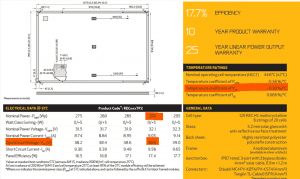Solar Panel Maximum Voltage Calculator – Why it’s important

With a solar power system it’s very important that the solar panels match the electrical characteristics of the solar inverter or charge controller that they’re connected to. So how do we work this out and what do you need to know? They’re good questions and this is where our solar panel maximum voltage calculator comes in handy! One of the electrical characteristics that are very important is the maximum voltage the solar inverter or controller can handle. That’s because if the voltage supplied from the solar panels is too high it won’t work and could be irreparably damaged.
Australian Standards PV array voltage requirements
Another important point is raised in the Australian Standard AS5033-2014 clause 3.1 which states the following:
“PV arrays for installation on domestic dwellings shall not have PV array maximum voltages greater than 600V. For non-domestic installations where the PV array maximum voltage exceeds 600V, the entire PV array and associated wiring and protection shall have restricted access.”
With these points to consider it’s very important that we know the maximum voltage of the solar panel systems. Luckily we have our solar panel maximum voltage calculator to help!
Note: This page deals specifically with the maximum voltages a solar power system will produce. Check out our solar panel voltage calculator page here for a calculator that covers both high and low solar panel voltage calculations.
Solar Panel Maximum Voltage – How to work it out
Working out the maximum voltage that your solar power system will reach is not a straightforward calculation. It’ll require information from the solar panel datasheet and some site-specific information to be entered into our solar panel maximum voltage calculator to calculate the maximum voltage the system will see. We need to take into consideration these 3 factors:
- The number of solar panels connected in a series string
- The minimum temperature found at the site
- The characteristics of the solar panels being used.
Let’s have a look at the information we require for our solar panel maximum voltage calculator, what it means and where you can get the information from.
Solar Panel Maximum Voltage Calculator – Information you need to know

Solar panel Voc at STC
This is the open-circuit voltage the solar panel will produce at STC, or Standard Test Conditions. STC conditions are the electrical characteristics of the solar panel at an airmass of AM1.5, irradiance of 1000W/m2, and cell temperature of 25oC. This information can be found from the solar panel manufacturers’ datasheet, please see an example here.
Solar panel temperature coefficient of Voc
The voltage that solar panels work at depends on the cell temperature. The higher the temperature the lower the voltage the solar panel will produce and vise versa. The voltage of the system will always be at its highest in the coldest conditions and the solar panel temperature coefficient of Voc is required to work this out. With mono and poly crystalline solar panels it’s always a negative %/oC figure, such as -0.30%/oC on the REC Twin Peak 2 290W solar panels. This information can be found on the solar panel manufacturers datasheet, please see an example here.
Minimum site temperature
This is very important and changes from site to site. As an example here on the Gold Coast near the beach, the lowest temperature is recorded as being 2.5oC by the Bureau of Meteorology. If you head up to Mount Tamborine in the hinterland the lowest temperature is recorded as dropping down to -1.1oC. To ensure the calculations are correct please check out the weather statistics for your local area.
No. of solar panels in a series string
When solar panels are wired in series strings (that’s the positive of one panel connected to the negative of the next panel), the voltage of each panel is added together to give the total string voltage. It’s therefore important to know exactly how many solar panels you intend to wire in series.
Got it all? Great, let’s go!
When you have all the information above you are ready to use the following solar panel maximum voltage calculator. This will quickly show if your solar panel design will suit your requirements. Just overwrite the data which is in the calculator – this data is for the REC 290W Twin Peak 2 solar panel used as an example above.



Hi to everyone, I have one short question. Does anybody have measured notes for belowed question.
What happens to the photovoltaic module if the voltage of string is higher than the maximum voltage of module. For example, if the voltage of string is 1400V and the maximum voltage of module is only 1000V.
Thanks in advance
Hi Fred, without knowing all the solar panel specs I can’t comment too much, however it sounds like the voltage from the panels is too low for your requirements.
I have an MPPT 48volt solar regulator with a PV array open circuit Voltage range @48v Battery from 64-95 VDC
I have two 24v/300watt panels in series and the open circuit voltage was 55.8(measured)Actual is supposed to be 29.76
The regulator seems to charge my battery bank but will not go past 51.6 volt. and will not go to either bulk or float.
Why is that.
Hi Ela, I would recommend installing solar panels through a MPPT charge controller, that gives you quite a lot of flexibility in regards to what solar panels you can connect to your power bank. Thanks
what if your power bank will be connected to solar panel and your power bank has 50v. what is the maximum voltage of panel that suits your power bank?